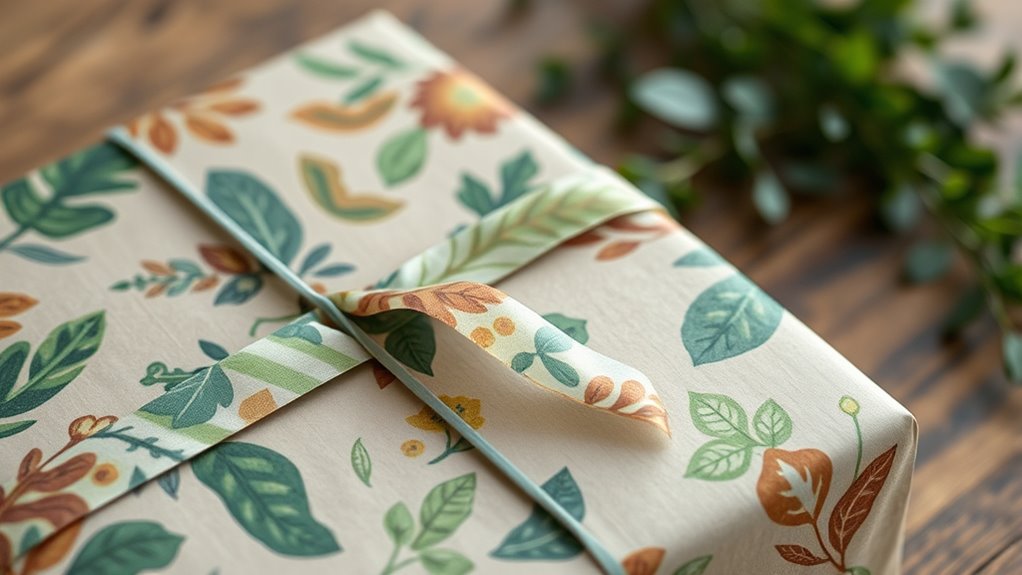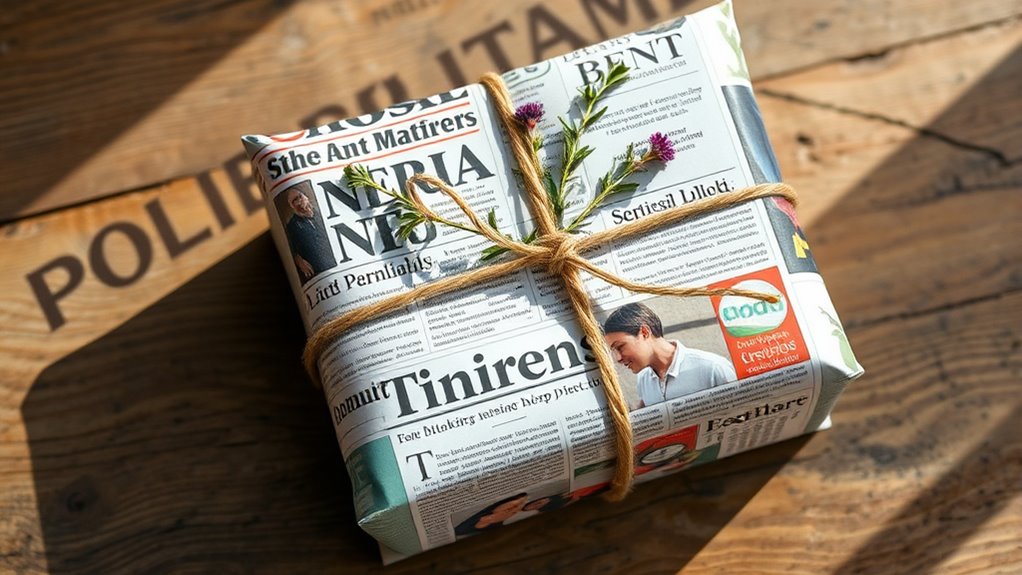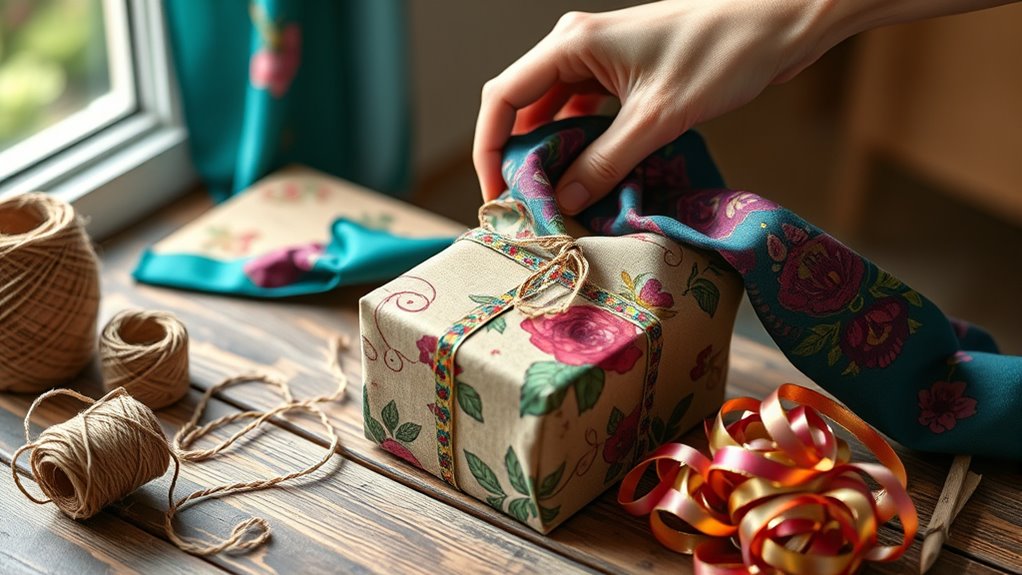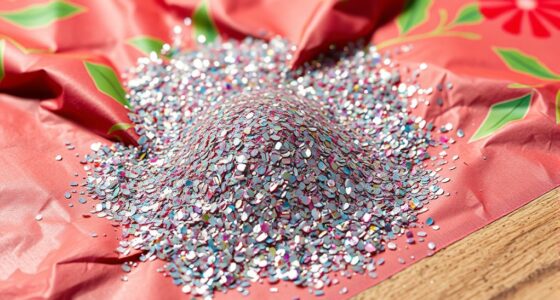To find sustainable alternatives to traditional gift wrapping tape, consider using biodegradable tapes made from plant fibers or biodegradable plastics that break down naturally. Reusable fabric wraps like Furoshiki, along with natural twine, jute, or hemp strings, add eco-friendly style and flexibility. You can also repurpose recycled paper tape, stickers, or even wrap with old newspapers and magazines for a creative, waste-free touch. Keep exploring these options to make your gift wrapping greener and more unique.
Key Takeaways
- Use biodegradable plant-based tapes made from renewable resources like cornstarch or cellulose.
- Opt for reusable fabric wraps such as Furoshiki or vintage scarves to eliminate the need for tape.
- Choose kraft or brown paper wraps decorated with natural stamps or drawings for a sustainable, decorative option.
- Incorporate biodegradable twine or natural adhesives instead of plastic tape for secure and eco-friendly wrapping.
- Reuse and repurpose materials like old newspapers, magazines, or recycled paper tapes to reduce waste and promote sustainability.
Reusable Fabric Wraps and Furoshiki

Have you considered using reusable fabric wraps and furoshiki for your gift packaging? These eco-friendly options replace traditional ribbon and plastic bows, reducing waste and adding a unique touch to your presents. Fabric wraps can be crafted from materials like cotton or silk, which you can reuse countless times. Furoshiki, a traditional Japanese wrapping cloth, offers versatility and elegance while eliminating single-use packaging. By choosing these methods, you avoid the environmental impact of plastic bows that often end up in landfills. Plus, fabric wraps and furoshiki can be personalized with colors and patterns, making your gift stand out. They’re simple to use, durable, and promote sustainability, helping you cut down on unnecessary waste while adding a charming, handcrafted feel to your gift presentation.
Kraft Paper and Brown Paper Wraps

Kraft paper and brown paper wraps offer a simple, eco-friendly alternative to fabric wraps and furoshiki. Throughout gift wrapping history, these papers have been valued for their durability and natural look. Unlike traditional decorative papers, they don’t require extensive processing, making them a more sustainable choice. When you use kraft or brown paper, you avoid the need for elaborate tape manufacturing processes, which often involve plastics and chemicals. Instead, you can secure your gift with simple twine or biodegradable adhesive options. Their neutral color makes them versatile for any occasion, and you can easily personalize them with stamps, drawings, or natural embellishments. Choosing kraft or brown paper helps reduce waste and supports eco-conscious practices while maintaining a classic, timeless presentation. Additionally, these papers align with TikTok trends that promote sustainable practices, helping spread awareness and encouraging environmentally friendly habits. Using natural embellishments like dried flowers or leaves can further enhance their rustic appeal and reduce reliance on synthetic decorations. Moreover, opting for these materials supports environmentally friendly packaging choices that minimize environmental impact.
Washable and Reusable Gift Wraps

Washable and reusable gift wraps offer a practical and eco-friendly alternative to single-use wrapping materials, allowing you to reduce waste while adding a personal touch to your presents. Their history dates back centuries, with many cultures valuing fabric wraps for their durability and significance. These wraps hold cultural importance, often symbolizing respect and thoughtfulness in gift giving. When choosing reusable wraps, consider these options:
- Fabric wraps like Furoshiki, rooted in Japanese gift wrap history and tradition
- Vintage scarves or cloth pieces that can be repurposed
- Embroidered or painted cloths with cultural significance
- DIY sewn wraps from old textiles, combining eco-consciousness with personal style
Using these wraps connects you to a meaningful gift wrap history while making your presents more sustainable. Sustainable wrapping methods promote a mindful approach to gift giving that benefits both the environment and personal relationships. Incorporating traditional fabric wraps not only honors cultural practices but also enhances the beauty and uniqueness of your gift presentation. Additionally, exploring innovative eco-friendly materials can further elevate your gift wrapping sustainably. Embracing textile-based wrapping also encourages creativity and personal expression, making each gift unique and memorable.
Plant-Based and Biodegradable Tapes

Plant-based and biodegradable tapes offer a sustainable alternative to traditional plastic options. These tapes are designed to break down naturally, reducing environmental impact and supporting composting efforts. Plus, plant-based adhesives guarantee the entire product remains eco-friendly from start to finish. Incorporating DIY crafts with eco-friendly tapes allows for more personalized and sustainable gift wrapping options. Utilizing biodegradable materials in these tapes ensures they decompose efficiently without leaving harmful residues. Additionally, choosing tapes with renewable resources further enhances their eco-friendly benefits. Because these tapes can be made from plant-based fibers, they provide an even more environmentally conscious option for eco-friendly wrapping.
Biodegradability and Compostability
As more people seek eco-friendly gift wrapping options, biodegradable and compostable tapes made from plant-based materials have gained popularity. These tapes often use biodegradable plastics and compostable films, which break down naturally without harming the environment. You can choose options that decompose quickly in composting systems, reducing waste. Here are four key benefits:
- Made from plant-based, renewable resources
- Break down into natural elements within months
- Do not release toxic residues during decomposition
- Help reduce long-term plastic pollution, supporting sustainable material use. Proper disposal methods and adherence to composting guidelines ensure these tapes are composted effectively and do not contaminate other waste streams. Additionally, employing biodegradable adhesives enhances the environmental friendliness of these tapes, ensuring they break down completely without leaving harmful residues. Understanding the biodegradation process can help consumers make more informed eco-friendly choices.
Plant-Based Adhesives
Since traditional adhesives often contain synthetic chemicals, many eco-conscious consumers turn to plant-based, biodegradable tapes as a sustainable alternative. These tapes use biodegradable glues made from natural materials like cornstarch, soy, or cellulose, reducing environmental impact. Plant-based adhesives provide strong adhesion while breaking down naturally without leaving harmful residues. They are free from volatile organic compounds (VOCs) and synthetic solvents, making them safer for both the environment and your health. You can easily find biodegradable tapes that utilize plant-based adhesives, which are perfect for eco-friendly gift wrapping. Additionally, biodegradable adhesives are designed to decompose naturally, further minimizing waste and pollution. By choosing these options, you guarantee your wrapping process remains sustainable without sacrificing functionality or convenience. These plant-based adhesives offer an effective, eco-friendly solution for wrapping needs while supporting biodegradable practices.
Natural Twine, Jute, and Hemp Strings

Natural twine, jute, and hemp strings offer eco-friendly options that add rustic charm to your gift wrapping. Their durable and biodegradable qualities make them both practical and stylish choices. To get the most out of these materials, consider tips on tying techniques and pairing them with other natural elements. Additionally, understanding payment security vulnerabilities can help ensure your transactions remain protected when purchasing these eco-friendly supplies online. Selecting appropriate materials can further enhance the sustainability and aesthetic appeal of your gift presentation.
Eco-Friendly Material Benefits
Eco-friendly materials like natural twine, jute, and hemp strings offer several compelling benefits for sustainable gift wrapping. First, they are biodegradable plastics alternatives, breaking down naturally without harming the environment. Second, these materials can be dyed with plant-based dyes, reducing reliance on synthetic chemicals. Third, their durability means you can reuse them multiple times, minimizing waste. Fourth, their natural appearance adds an authentic, rustic touch to your gifts without the need for artificial embellishments. Using these materials supports eco-conscious choices and reduces your carbon footprint. Plus, they align with sustainable practices by avoiding harmful plastics and synthetic dyes, making your gift wrapping both beautiful and environmentally responsible.
Style and Aesthetic Appeal
Using natural twine, jute, and hemp strings instantly elevates the look of your gift wrap with their earthy, rustic charm. Their neutral tones and textured finish create a warm, inviting aesthetic that complements various wrapping papers and decorations. By carefully considering color coordination, you can enhance the overall visual harmony of your presentation, making each gift look thoughtfully curated. These strings add a handcrafted touch that feels authentic and personal, standing out without overwhelming your design. Whether you choose a simple bow or intricate knot, their natural appearance lends an understated elegance. Overall, natural twine, jute, and hemp strings help you craft a cohesive, stylish presentation that emphasizes simplicity and sustainability with undeniable charm.
Practical Usage Tips
To get the most out of your natural twine, jute, and hemp strings, it’s important to choose the right thickness and length for your gift. Thicker strings offer better traditional tape durability, ensuring your wrapping stays secure. Shorter lengths help you work more quickly, speeding up gift wrapping. Here are some practical tips:
- Opt for medium thickness for a balance between strength and ease of tying.
- Cut longer pieces for larger gifts to avoid re-cutting.
- Use a sharp scissors for clean cuts, saving time and effort.
- Wrap tightly and knot securely to prevent slipping, reducing the need for tape repairs.
- Considering eco-friendly packaging can be a sustainable alternative for transporting large gift packages, reducing your carbon footprint during busy holiday seasons. Additionally, practicing creative practice can help you develop innovative ways to enhance your gift presentation with natural materials. Incorporating sustainable materials into your wrapping not only benefits the environment but also adds a unique rustic charm to your gifts.
These tips help you maximize gift wrapping speed while maintaining a rustic, eco-friendly look.
Recycled Paper Tape and Stickers

Recycled paper tape and stickers offer a simple yet effective way to make your gift wrapping more sustainable. They help you achieve minimal waste because they’re biodegradable and often made from post-consumer materials. Plus, their natural textures and muted colors add to the aesthetic appeal of your wrapped gifts. You can easily find recycled paper tapes that are sturdy enough to secure packages without sacrificing style. Stickers made from recycled paper can serve as decorative accents or functional labels, further reducing the need for plastic ribbons or synthetic embellishments. By choosing these eco-friendly options, you not only enhance your gift’s presentation but also support environmentally conscious practices. Recycled paper tape and stickers truly combine practicality with visual charm, making your gift-giving both beautiful and responsible.
DIY Wrapping Using Old Newspapers and Magazines

Repurposing old newspapers and magazines for gift wrapping offers a creative and eco-friendly alternative to conventional materials. This approach challenges recycling myths, showing that repurposing can reduce environmental impact and avoid unnecessary waste. To get started:
Transform old newspapers and magazines into eco-friendly, creative gift wraps that reduce waste and add a personal touch.
- Choose colorful magazines for vibrant, eye-catching wraps.
- Use plain newspapers for a classic, minimalist look.
- Reinforce with biodegradable twine or string instead of plastic tape.
- Add handmade accents like ribbons or stamps to personalize your wrap.
This method minimizes waste and promotes recycling awareness, making it a sustainable choice. By using materials you already have, you avoid the environmental impact of buying new wrapping supplies. Plus, your gifts will stand out with a unique, creative touch that’s good for the planet.
Eco-Friendly Adhesive Alternatives

When looking for eco-friendly adhesive options, you can replace traditional glues and tapes with natural, biodegradable alternatives that are gentle on the environment. Plastic alternatives like plant-based glues, beeswax wraps, or rice starch adhesives offer sustainable solutions that break down easily without harming ecosystems. Adhesive innovations have also led to compostable tapes made from cellulose or other biodegradable materials, providing effective sticking power without plastic waste. These options eliminate harmful chemicals found in conventional adhesives, reducing your ecological footprint. By choosing these eco-friendly adhesives, you help minimize plastic pollution and support the development of sustainable materials. Not only do they perform well, but they also align with your goal of reducing waste and protecting the planet.
Creative Use of Decorative Cloth and Scarves

Decorative cloth and scarves offer a stylish and sustainable alternative to traditional wrapping paper, transforming gift presentation into an eco-friendly art form. Using decorative fabric or scarf wrapping, you can create beautiful, reusable gift coverings that add a personal touch. Here are four ideas to get started:
- Wrap gifts with a colorful scarf, tying it with a simple knot or bow for an elegant look.
- Use decorative fabric to cover irregularly shaped items, securing it with a fabric tie or string.
- Choose patterned scarves to complement the gift, enhancing visual appeal without extra decoration.
- Repurpose vintage or spare scarves, giving them a second life as unique wrapping material.
This approach reduces waste and elevates your gift presentation creatively.
Frequently Asked Questions
How Do Sustainable Wraps Compare in Durability to Traditional Plastic Tape?
You might wonder how sustainable wraps stack up against traditional plastic tape in durability. Generally, sustainable options like paper-based or plant-based wraps are quite strong but may not be as waterproof as plastic. They can withstand typical handling and are easier to recycle due to simpler recycling processes, reducing environmental impact. While they might need more careful application, their eco-friendly nature makes them a better choice for minimizing waste and supporting sustainability goals.
Are Eco-Friendly Tapes Suitable for Wrapping All Types of Gifts?
Imagine your gift as a treasure chest, and eco-friendly tapes are the gentle guardians that secure it. Reusable fabric tapes with plant-based adhesives suit most gifts, much like a versatile key fitting many locks. However, for delicate or uneven surfaces, they might not hold as firmly as traditional tape. Still, they’re perfect for eco-conscious wrapping, offering durability and sustainability in one, transforming your gift-giving into a mindful act.
Can Reusable Wraps Be Safely Used for Food Items or Perishables?
You can safely use reusable wraps for food items if you prioritize food safety and reusable cleanliness. Make sure the wraps are specifically designed for food contact, like beeswax wraps or silicone, which are easy to clean and maintain hygiene. Avoid using non-food-grade materials, and wash your wraps thoroughly after each use. By doing so, you guarantee your reusable wraps stay safe, clean, and suitable for perishables.
What Are the Best Methods to Compost Biodegradable Wrapping Materials?
You can compost biodegradable wrapping materials by first checking their compostability standards to guarantee they break down properly. Tear or chop the materials into smaller pieces to speed up decomposition. Then, mix them into your compost pile, balancing green and brown materials for ideal soil enrichment. Regularly turn the compost to aerate, and within a few months, you’ll have nutrient-rich soil that benefits your garden.
How Can I Ensure My Eco-Friendly Wrapping Looks Professionally Finished?
You’re on the right track to make your eco-friendly wrapping look polished. To give it a professional finish, pay attention to finishing techniques like neat folds, secure ties, and smooth edges. Add decorative accents like natural twine or dried flowers for a charming touch. Remember, a little extra effort goes a long way—think of it as dressing up your gift to impress. With some care, your wrapping will look as good as it feels good!
Conclusion
By choosing these sustainable gift-wrapping options, you’re not just giving a present—you’re making a powerful statement for our planet. Switching to eco-friendly tapes, reusable fabrics, and creative DIY methods can drastically reduce waste and save countless trees. Every small change you make is like planting a forest of hope for future generations. So, embrace these greener alternatives and turn your gift wrapping into a mighty act of environmental kindness that could change the world!









